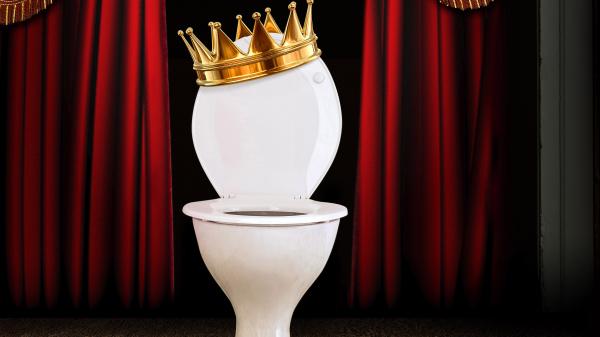The Golden Thrones: the best and worst loos in theatreland
reviewed for The Times, 8th April 2016

Image Source: Getty Images
Nothing puts a damper on a night at the theatre quite like a substandard bog. Cramped jakes, vermin-infested crappers, inaccessible “disabled” loos — the lavatorial crimes of the nation’s arts venues are legion.
Insufficient provision for women is a perennial problem in theatreland, especially in older theatres. Men take an average of 55 seconds to shake a tail feather; women need three times as long in a cubicle. Some theatres are going gender-neutral: the Understudy bar at the National Theatre now has two banks of facing cubicles for men and for women around a communal set of sinks, as does the Storey Institute in Lancaster. Great if you want to break down the prison of the gender binary, less great if you’re a woman who would like to do her make-up without a bloke watching you squeeze your pores.
Yet the battle of the sexes was by no means the only problem highlighted in our survey. Horror stories proliferate about ill-equipped facilities (note to theatre managers: an abundance of flyers for your venue’s less popular events are not a substitute for loo paper). The indie music venue at the Bull and Gate is sadly no more; famously described as having the “smell of the gorillas’ cage at London Zoo”, it required patrons to enter through a pub’s toilet. (The posher, newer, Trafalgar Studios 1 isn’t much better, if you’re heading to seats on the left of the auditorium).
The price of maintenance is usually touted as an excuse by smaller theatres caught short, as are the spiralling costs of property in London, which keep fringe venues from expanding. So the Jermyn Street Theatre can afford only one set of loos, backstage, for performers and patrons alike — you access them by running across the stage (preferably not during the performance). Wyndham’s Theatre has crammed the two ladies’ cubicles in the stalls into such a tortuous space that it’s like weeing in a cubist painting.
Even so, impresarios are keen to prove that things are getting better: after renovating the Duchess Theatre, the producer Nica Burns was said to have marched male critics into the loos one by one to order an immediate test drive. Newer venues, such as the Leicester Curve or Manchester’s HOME, look like the future.
So without further ado, the fruit of serious research and much personal discomfort, here is our list of the best and worst loos in theatreland.
Best

Image Credit: The Wales Millennium Centre
All-rounder
Shakespeare’s Globe
Fortunately, the venue’s commitment to Jacobean authenticity doesn’t extend to the jakes, and for comprehensive efficiency it’s hard to beat the Globe. With five toilets for disabled people, it’s a beacon for access. Best of all is the huge women’s section on the first floor, just past the gift shop. Plenty of cubicles, a wide mirror with good space for make-up, and a bank of top-of-the-range Dyson Airblades that will blast the skin clean off your hands. Most importantly — and hereby the Globe earns its place in Heaven — it has a separate exit, next to the entrance. Nothing keeps a queue moving more swiftly.
Kept secret
House restaurant toilets, the National Theatre
The National, like most multivenue centres, is great for bog-hopping. The theatres hold intervals at different times, so as the crowd surges out at the Olivier, head to the Lyttelton, or vice versa.
If you want to jump the queue, cut through the newly renovated House Restaurant by the Lyttelton’s upper circle (I recommend the raspberry pavlova if you’ve time to stop) and check out the loos hidden away for the National’s gastronome patrons. The men’s has privacy shields with art deco tiling and the women’s is well lit with a decent shelf behind each toilet so you don’t have to dump your bag on the floor.
Royal flush
Royal box, Royal Opera House
The sacred seat of the royal posterior is the stuff of legend. Formerly a highlight of the Royal Opera House’s public tour, the press office declined to give your correspondent a glimpse. That hasn’t stopped a Times source from finding the mahogany throne unlocked one night and trying it for size (“huge armrests”, says our girl with her ears — or cheeks — to the ground). The Duke of Bedford owns Covent Garden’s land and maintains rights to the box next door, which comes with a cute Victorian blue and white porcelain bowl. Oddly enough, neither he nor Her Majesty — whose approach to culture David Starkey once compared to Hermann Goering’s — frequently take up their seats.
For disabled loos
Wales Millennium Centre
Given the poor provision of disabled toilets in arts venues nationally, the Wales Millennium Centre is a breath of fresh air. The Touch Trust, resident in the centre, provides art therapy for those with complex disabilities, so it’s no surprise to find thoughtful disabled toilets offering vertical and horizontal handles, a changing table and plenty of room to manoeuvre. Elsewhere, the New Diorama in London has a disabled toilet so spacious that the venue’s founder, David Byrne, claims to have spent his first few months on site sleeping in it.
For children and babies
The Polka Theatre in Wimbledon
This wins rave reviews, which is reassuring for a theatre aimed at children and families. Great changing facilities in the women’s and the men’s — because men are parents too — as well as cute toddler steps available everywhere for your little ones to climb up to the height of the grown-up loo. The Sheffield Theatres (Crucible, Lyceum and the Crucible Studio) also impress.
For pick-ups
Menier Chocolate Factory and the Young Vic
Ovid recommended it, the Elizabethan Puritans warned against it, but people have headed to the theatre to find a lover since stories were first performed around a campfire. If you’re a man seeking a man, the Menier Chocolate Factory and the Young Vic both offer “excellent angles for checking out each other’s equipment”, says our mole, but the Courtyard in Hoxton is really the place to be. “I’ve walked in on people shagging twice,” says one theatre professional.
For environmental friendliness
Arcola Theatre
If you want to congratulate yourself on your carbon footprint, head to the Arcola Theatre in Hackney, northeast London, for greener-than-thou goodness. The toilets use the compact Roca W+W system, refilling the cistern with water from the hand basin. The Arcola likes to lecture its neighbours on eco-sustainability: in 2013 the loos played host to performances of Cape Theatre Company’s FLUSH, which laments water waste in Britain. Exactly what you’d expect from Dalston.
Arts venue in a former loo
CellarDoor/Arts Lav
Directors love lavatorial humour on stage: Trainspotting, which closed recently at the King’s Head in Islington, north London, featured one of the most repulsive on-stage toilets I’ve seen in nearly thirty years of theatregoing. More appealing is the craze for converting public toilets into theatres. CellarDoor, just next to the Aldwych in the West End, is a subterranean temple to cabaret: nervous patrons should note that the gents’ transparent doors frost over once occupied. The ArtsLav, in Kennington, London, offers performance poetry amid Victorian toilet cubicles and the Edwardian Cloakroom in Bristol is always worth checking out for live and visual arts.
WORST

Image Credit: Alamy
For female capacity
Prince Edward Theatre
Women make up 65 per cent of West End theatre audiences, but we’re nowhere near achieving potty parity. It’s hard to fathom why a (male) theatre critic once called Cameron Mackintosh “the patron saint of ladies’ loos”: when playing to a full house his Prince Edward Theatre hosts more than 75 women for every women’s toilet cubicle. The Dominion isn’t much better, at 68 women a loo (and they’ll make you see The War of the Worlds while you’re there). And even the London Palladium, which boasts 48 sparkling women’s loos thanks to a recent renovation (34 ladies for every lav), would need another 50 to achieve adequate provision, according to the British Standards Institution. You’re better off crashing the local Nando’s.
For men
Barbican
Chaps don’t ask a lot from their loos. Decent heating, perhaps a privacy partition between urinals or — if you’re pushing it — a shoe-guard. Mention the Barbican toilets, however, and grown men shake. No urinals, just two 20ft troughs that pass for pissoirs. The foot pedals which operate the sinks are unpredictable — scalding gush or freezing trickle, although some respondents seem to enjoy playing with them. dishonourable mentions include the Pleasance Theatre — “Just think of it as the poor man’s Barbican,” reports my male research assistant — and the Arts Theatre: “Anyone who opens the door in a less than gingerly fashion will cause mayhem.”
For location
Vaudeville Theatre
Here’s a tip. If you’re designing a theatre and you suspect the women’s lavatories might disgorge a snaky queue, don’t situate them in the path to the bar. Exit the Vaudeville Theatre at the back of the auditorium and you’ll walk bang-wallop into a gang of disgruntled matrons lining up for the little girls’ room. Similarly, the Royal Festival Hall includes male lavatories only accessible by walking through a narrow space shared by the women’s queue. Arm yourself with copious apologies for your male (anatomical) privilege and run the gauntlet.
For disabled access
Fortune/Ambassadors/Vaudeville
Back to the serious issues: the West End’s failure to abide by the basic tenets of equality of access can be jaw-dropping. Neither the Fortune Theatre nor the Ambassadors have any disabled toilets, while the Vaudeville expects patrons to use the neighbouring Adelphi. Not good enough.
For backstage
King’s Head, Islington
“You’ve worked at the King’s Head, Islington?” Thespian survivors recognise each other with a grim nod. The venue’s contract with theatre companies bans “unsuitable materials” from the “delicate and fragile” backstage cistern — which, it turns out, means all solids. Actors intending to take a number two are required to mix with the punters in the pub theatre’s front-of-house loo, which can lead to overhearing unwelcome interval feedback. They can blame the decline of their own potty on the nameless celebrity who came to “support” his boyfriend in the show — and left a condom in the antique U-bend.
Special award — an absolute stinker

Image Credit: Fifth Instar
Union Theatre
“Like something out of an apocalyptic road movie” . . . “no self-respecting rat would be seen anywhere near the place” . . . “even worse than the Barbican”. The respondents to The Times’ Great Lavatory Survey were unequivocal. The Union Theatre in Southwark, where The Great Gatsby has just opened, is the UK’s worst theatre latrine.
A sign on the men’s cubicle bans patrons from flushing during the performance because the lack of soundproofing ensures each guzzle can be heard on stage. Whatever you do, don’t sit on the far right of the auditorium if you want to survive the smell.
Fortunately, hope dawns. The theatre’s resourceful director, Sasha Regan, has finally secured a move across the road, expected to take place later this year. “We will have five cubicles and a disabled toilet,” she emails me, adding in capital letters: “ALL SHINY AND NEW.” Perhaps the self-respecting rodents, and my fellow critics, will finally pay it a visit.






